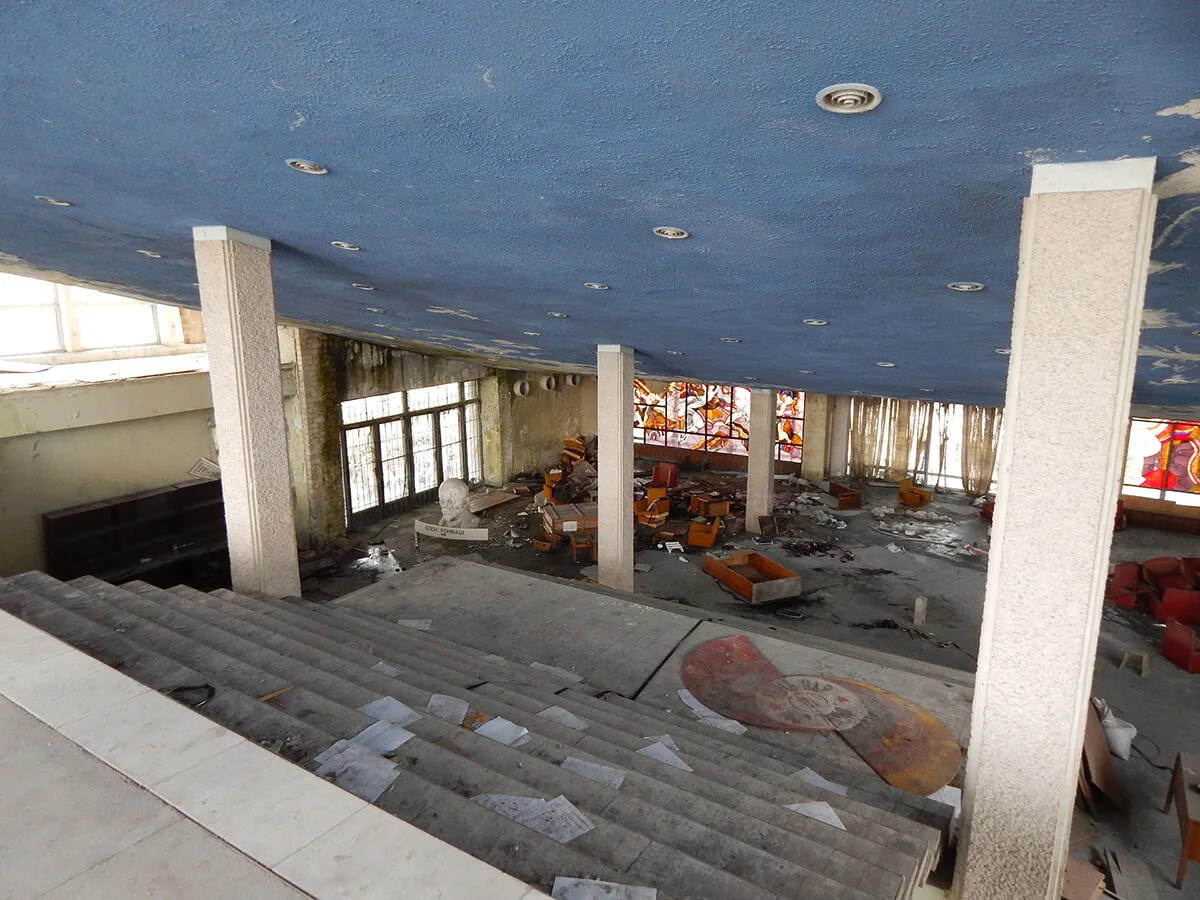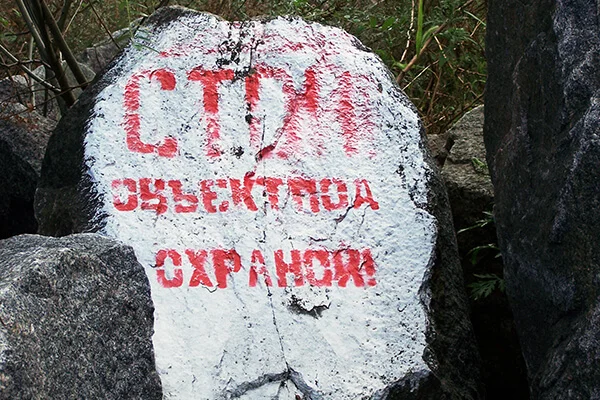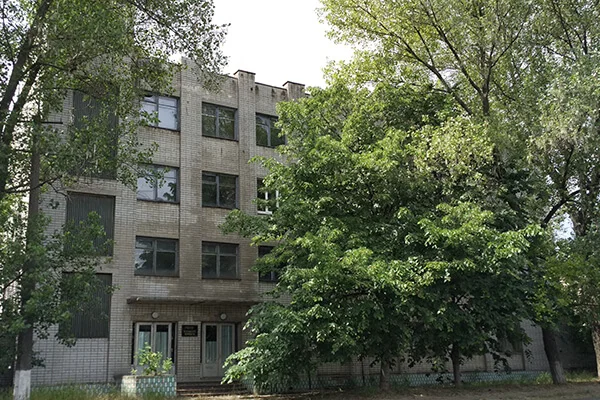
Elektronmash
A sad ending to the history of the legendary “Elektronmash”, a famous Kyiv enterprise for the production of domestic computers
Abandoned plant of SPA «Electronmash» – Kyiv, Ukraine.
The remains of a large industrial enterprise were sold three times. The first potential owner bought the company for UAH 970 million. 22 companies took part in the auction, but the winner subsequently abandoned his obligations. The second auction took place in January 2021, 5 companies competed for the assets, the selling price exceeded the starting price by 6.6 times and amounted to UAH 430 million. The victory was won by the company “Ukrainian Image” LLC (founder Violeta Glinyanchuk, authorized capital 50 thousand UAH). But she did not fulfill her obligations in a timely manner, and the results of the auction were canceled.
The Elektronmash plant was sold for the third time in May 2023. 6 companies competed for the right of ownership, the final price was UAH 121 million, which was twice the starting price. The winner was Inkom Rent LLC, which owns 37 real estate properties. As you might guess, there is no talk of resuming production; the new owner plans to use the land for construction.
In total, the workshops of the Elektronmash plant occupy an area of 18 hectares, including 14 hectares near the Zhitomirskaya metro station, and two other sites are located in the Kyiv and Zhytomyr regions. The company has been allocated 20 days to pay the funds, during which time it is obliged to pay off debt encumbrances in the amount of UAH 23 million. and VAT in the amount of UAH 24.2 million.
At the time of the sale, the general director of the research and production state enterprise was Alexander Yurievich Plotnikov, the number of employees was 333 people. The company declared various areas of activity – from the production of computers and household appliances to catering services. Legal address: Kyiv, st. Ring road, 4. At the time of implementation, the company leased out part of its space, the rest were launched or sold to shopping and entertainment centers and supermarkets. There was virtually no electronics production.


The emergence of the first domestic computers
Boris Nikolaevich Malinovsky (1921–2019) is considered the “father” of Soviet computing technology. Under his leadership, the Dnepr universal multi-purpose vehicle (UMSP) was developed. The machine was created using transistors; the memory media were ferrite cores with a diameter of 0.5 mm. Thanks to the use of components that were new at that time, the speed of the machine reached 10 thousand operations/second, which was at the level of its American counterparts. As the scientific director of the project, Academician V. M. Glushkov noted, the developers managed to create a machine that practically kept up with Western competitors.
In America, the first samples of computer technology (RW300) using semiconductors appeared in 1961. To test the Soviet UMBP, a special commission of outstanding scientists was created, headed by Academician A. Dorodnitsyn, the founder and first director of the Computing Center of the USSR Academy of Sciences. After extensive checks, the commission gave permission to launch the development into mass production. It was planned to use them only in industrial enterprises and scientific laboratories.
If everything was in order with scientific developments, then serious difficulties arose with the production process. The reason is trivial – the lack of necessary equipment, components and professional personnel at that time.


Foundation of the Kyiv specialized plant
The first special division for the production of computers was organized at the Kiev plant “Radiopribor”, it was here that the first samples of the Dnepr UMSP were manufactured in 1962. however, the build quality left much to be desired, since neither the plant management nor the staff were ready to work with such devices, which required special configuration and an almost individual approach.
Since the 1960s, the accelerated development of computer technology began. Research institutes, specialized design bureaus and enterprises were created throughout the USSR. The construction of the plant in Kyiv began on the initiative of Academician Glushkov, he was supported by the state leadership, allocated the necessary funds and personnel. On April 5, 1962, the Council of Ministers of the USSR adopted Resolution No. 309 on the creation of the plant. In the vicinity of the city, on the lands of the Sovki state farm, the construction of the Kyiv plant of electronic computing and control machines began (later the main enterprise of the Elektronmash plant). In 1965, the enterprise was put into operation and began to supply the USSR with computer equipment in many areas of the national economy. It was there that the production of the country’s first multi-purpose control machine (UMSHP) “Dnepr” began.


Reaching the factory
- 1966 год. ЭВМ “Мир-1” на международной выставке “Интероргтехника” получила высокую оценку и была закуплена фирмой “IBM”.
- CM-3 management computer systems were purchased by Algeria, Bulgaria, East Germany, Hungary, Poland, India, Finland, Czechoslovakia, Sweden, Yugoslavia and Cuba.
- “EMRT-3” – “Kashtan” was adapted to automate the calculation of a batch of material for workpieces. Assortment requirements were controlled and dead residues were minimized. Used in clothing, metallurgy, engineering and other industries. According to its purpose, it was the only one in the world, patented in the USA, England, France, Germany, Italy and Japan.
- In 1986, the company successfully completed an urgent government task of manufacturing printed circuit boards for remote control of tractors. The equipment was used to eliminate the consequences of the Chernobyl nuclear power plant accident.
On January 1, 1965, on the basis of some Radiopribor workshops, a separate special enterprise was created – the Kiev Plant of Computing and Control Machines (CM). In addition to fixed assets, he was given the building of a production building on the Ring Road (B. Okruzhnaya, 4), three workshops (assembly, technical-mechanical and debugging) and a special design bureau (SKB). The total number of employees was initially 460 people.
Simultaneously with the debugging of the production of Dnepr machines, a department was created at the plant to help consumers master the available hardware and software and write down the requirements for new machines.
A good example of the work of this team is the history of the Whirlwind project, when it was necessary to develop a system for automating data recording during testing of the first stage of engines of new types of rockets intended for a rocket for an expedition to the Moon. There was a problem of collecting in a short period (up to 300 seconds) a significant amount of various information from sensors installed on the engine, as well as analyzing it in real time. The Dnepr MSHP was chosen as the basis of the entire system, and it was significantly modernized for use in the system.
For this purpose, the machine’s RAM was increased from 512 to 4096 26-bit words and peripheral communication devices with rocket engine units were designed. In the fall of 1965, the entire system was installed at the Space Flight Control Center (SFC) and contributed to the world’s first robotic exploration of the far side of the Moon and soft landing on the surface of the Earth’s satellite. By the fall of 1965, the tasks of the Whirlwind project were successfully completed, the vehicles were delivered to the design bureau of the Chief Designer of Missiles of the USSR.
Apollinariy Fedorovich Nezabitovsky (1918–1991) was appointed the first director of the enterprise. He had not previously dealt directly with computer technology and held other leadership positions in industry, but the best years of the formation and development of the Kyiv VUM plant are associated with his name. Within a year, the new director eliminated the dependence of his enterprise on the “mother” radio device and achieved complete independence.
In 1966, a technical school and school for training young personnel was opened at the plant; In parallel, there was a process of recruiting professionals from computer centers and similar enterprises in other cities and republics – Severodonetsk, Minsk, Kazan, etc. This approach allowed the company to independently train professional personnel, which had a positive impact on product quality.
In 1972, NPO Elektronmash was created on the basis of the Kyiv plant of computing and control machines. Under him, a research institute for peripheral equipment was opened. The company began developing and mastering the production of new models of external devices: drives (magnetic disks and tapes were used), graphic and digital screen consoles, printing devices, graphic plotters, graphic information input systems, seismic activity recording sensors, data transmission multiplexers.
As a result, by the end of the 1970s, the association and its branches employed more than 10 thousand people. Dormitories and houses with modern apartments for employees, three kindergartens and the pioneer camp “Vumovets” were built. There was a canteen and cafe, a factory clinic and stadium, and recreation centers on the banks of the Ros and Desna rivers. Specifically, they now turn out to be more attractive to possible investors in the era of privatization.
The scientific team of “Electronmash” has developed an effective method of output control; for this purpose, the problem-oriented complex “KODIAC” was designed. The control system received recognition and became widespread in many organizations of the USSR. The introduction of this complex into the creation solved the problem of failure of blocks of parts – the installation process of all types of computers was shortened and the reliability of the equipment increased. In 1988, Elektronmash completed the development and began production of the first PCs “Poisk-1” and “Nivka”.
“Electronmash” developed and produced electronics until 2015-2016: multimedia complexes for educational institutions, electronic cash registers, devices for electric transport, control modules for wind power plants, automatic metering systems for natural gas, medical equipment.






Events that influenced the development of computer production
If in the first 1950s, domestic scientists could find advanced solutions in the development of computing technology, then already in the mid-1960s America overtook us in many respects. In addition, thanks to the rapid establishment of mass production and its distribution throughout the world, the Americans were able to achieve the most important thing – the world switched to their standards.
At the beginning of 1967, substantive discussions took place in government and academic circles on the topic of further strategy for the development of domestic computers. As a result, the only correct decision was made – to make our own machines compatible with the American IBM System/360.
As expected, well-known scientists S.A. Lebedev, A.A. Dorodnitsyn, V.M. Glushkov, who were still living in the stereotypes of war, spoke out against it.
Compatibility meant quick production setup, cost and time savings, and a significant expansion of the sales market. Moreover, many countries have already adopted such a standard, including members of the Warsaw Pact. Another factor that influenced the decision was the scattering of scientists’ efforts to solve problems that had already been solved. This means extra money and wasted time.
Kiev “Electronmash” has launched the production of a new series “Mir”. However, as often happened in the USSR, they decided to insert their own development “to spite America.” All our decision algorithms were implemented in passive memory, which significantly slowed down and reduced the capabilities. Foreign manufacturers solved such problems using external and RAM memory and achieved a significant advantage. America quickly realized that electronics were the future and vetoed the export of products to countries influenced by the USSR. As a result, we had to start producing cars using domestic components.
Elektronmash's own developments
During its heyday, the company had more than 10 thousand employees. We have created our own design department, research institute, selected personnel and production facilities. The range of more recognizable developments has expanded to include the following machines.
- Aggregate system of computer equipment. The first machine in the USSR using M4000 integrated circuits. Compatible with American IBM System/360 and domestic EU computers. The M4030-1 control computer complex underwent subsequent modernization.
- External memory devices on all types of magnetic media, parallel alphanumeric printers (ADP), wide-format graphic displays, recording devices. The products were compatible with a wide range of domestic computers.
- Computers of the RM computer family with a full set of peripheral devices. Compatible with American PDP-11.
- Minicomputer SM1800. The KR580VM80A processor was used, which was a licensed analogue of the Intel 8080.
- KODIAC system. Automatic complex for monitoring large blocks of electronic equipment. It allowed not only to constantly monitor the condition of the equipment during operation, but also to simplify its installation and commissioning.


Reasons for the decline of the enterprise
By the mid-1980s, it turned out that the domestic production of computer equipment was hopelessly behind the world level. The company did not have advanced technologies, integrated circuits, laser optics, precision and productive machines. The market for Western equipment opened in the USSR, consumers had the opportunity to choose better and cheaper goods. As a result, Elektronmash could not withstand the competition, and government subsidies to cover losses stopped.
A huge team (about 10 thousand employees) produced up to 30 thousand computers per year (3 units per year per person). With such indicators it is impossible to think about the prospects for further existence. Scientists continued to develop new systems for some time, but their production had serious problems. Debt increased, staff were fired. At the end of the 1990s, the enterprise ceased to exist as a production complex.






